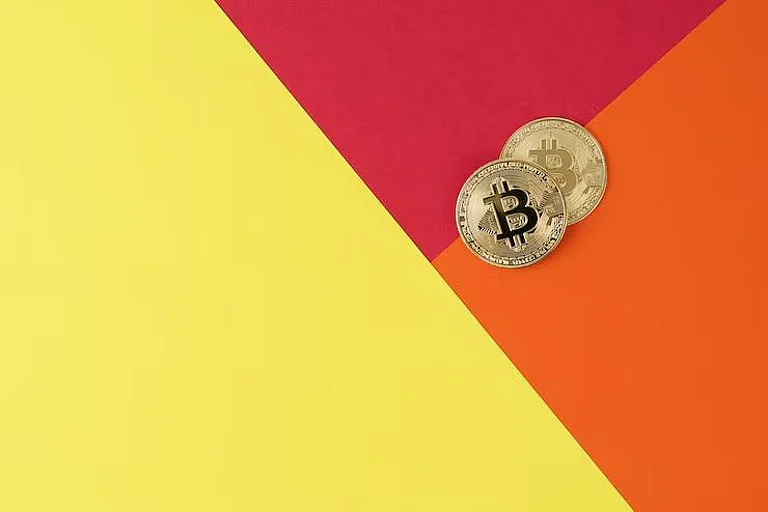Ever felt overwhelmed by the world of cryptocurrency? You're not alone. This guide is your starting line. We've stripped away the complex jargon to give you a clear, simple introduction to the absolute essentials. You'll learn what crypto is, how the technology works, and the exact steps to safely buy and store your first digital asset. Move from curious to confident and begin your crypto journey today.
What is Cryptocurrency?
Picture money that's completely online - money that you can send to anyone, anywhere on the planet, at the speed of light, without a bank in the middle. That's cryptocurrency.
Cryptocurrency is digital money that uses cryptography to make the transactions open, safe, and almost tamper-proof. It is not printed or produced by governments or physically in paper form notes and coins. Instead, it's data on a public electronic ledger called a blockchain.
It is the currency of the digital era. Where institutions are relied on to verify transactions in the traditional money, cryptocurrency replaces that with mathematically computed verification. Every crypto transaction is verified by a global network of computers, doing away with the middleman and allowing it to make peer-to-peer transactions.
This new system of money disrupts the world's understanding of finance, ownership, and trust, and that is why it is one of the most revolutionary inventions of our time.
Your 5-Minute Quick Start Guide
Getting started with cryptocurrency doesn’t have to be overwhelming. Here’s a quick, actionable roadmap to get you into the world of crypto in just a few minutes:
1. Choose a Reputable Exchange
Select a trusted cryptocurrency exchange that offers strong security, transparent fees, and an easy-to-use interface. Popular examples include Coinbase, Binance, and WazirX (for India).
2. Create and Verify Your Account
Sign up and complete the Know Your Customer (KYC) process by submitting ID and proof of address. Verification ensures your account is secure and compliant with regulations.
3. Buy Your First Crypto
Deposit funds into your account using a bank transfer, credit/debit card, or UPI. Then, purchase a small amount of a major cryptocurrency like Bitcoin or Ethereum to get started.
4. Prioritize Security
Set up strong, unique passwords and enable Two-Factor Authentication (2FA) on your account. Consider transferring your crypto to a wallet for safer, long-term storage.
Key Differences from Traditional Money
Decentralization: Centralized fiat currency like the US Dollar or Indian Rupee are printed and controlled by a central bank. They control supply, set interest rates, and control inflation. Cryptocurrencies are decentralized. Nobody controls them. Thousands of individuals worldwide utilize the network. It is transparent, censorship-resistant, and democratic as anybody with a computer can help with verifications of transactions. Decentralization gives power to the people. Because it stops governments or companies from freezing accounts, tampering with supply, or cutting willy-nilly.
Transparency: Everything in crypto is written onto the blockchain — a public ledger that anyone can see. Each and every transaction that is made is time-stamped and dated, confirmed, and sealed away forever. This is a liberty you do not have to report to someone else about; you can study it all by yourself. Although the blockchain is available to the public, it provides anonymity for users through wallet addresses rather than individual names — a balance between secrecy and responsibility.
Accessibility: Whereas the old school banks are sticklers for formality, minimum balance, or creditworthiness, you can play around with cryptocurrency provided you have an internet connection. Whether you are in New Delhi or Nairobi, you can send and receive cryptocurrencies instantly without any intermediary. This availability of finance makes crypto very resilient in nations where there is weak access to the banking sector. For tens of millions, it is the first real chance to become part of a digital global economy.
How Does Cryptocurrency Actually Work?
How Blockchain Technology Works
At the center of it all is blockchain technology — the digital platform where it's all founded on.
A blockchain is an open, immutable register that has all transactions ever conducted. Rather than sitting on one server, there are thousands of the same data set in different machines (nodes) around the globe.
When you conduct a transaction, it's bundled with others and sent as a "block." The network checks each block, and then they're appended to the record book of all prior transactions — creating an unbroken, irreversible chain.
What is new with blockchain is that it removes the requirement for trust. You no longer have to trust a bank or payment provider in order to hold money or to make a payment — the blockchain provides you with that trust through math and consensus.
The Lifecycle of a Crypto Transaction
When you exchange cryptocurrency, a few things happen behind the scenes — an unseen process that is the combination of blockchain openness, network agreement, and programming so that all transactions are valid and secure:
1. You use your private key, your digital signature, to make a payment out of your cryptocurrency wallet. Your mathematically calculated signature proves you to be the owner of money and instructs funds to be moved. Unless someone knows your private key, no one is able to send your money — it is therefore the basis for crypto security.
2. The information for the transaction — receiver wallet address (public address), sender, and amount of money to be transferred — is then sent to the blockchain network. It is like sending an encrypted message to a global ledger with hundreds of computers waiting to authenticate your action.
3. The network nodes (individual computers with the blockchain program installed on them) witness this transaction and begin to verify its legitimacy. They ensure that you have sufficient balance in your wallet, your signature created through your private key properly matches your public address, and you are not attempting to double-spend coins — an anti-double-spending mechanism that cannot be implemented once a transaction gets confirmed.
4. After verification, the verified transaction is transferred into a group of other transactions into a new block. A block must be verified by some consensus protocol — either mining in the case of Proof-of-Work (PoW) protocols like Bitcoin or verification in the case of Proof-of-Stake (PoS) protocols like Ethereum.
In mining, there are fast computers competing against each other in trying to solve complex cryptographic challenges to get their block added to the chain and receive an award.
In validation, legitimate actors (validators) lock coins of their own to clog up the network and confirm transactions quicker and using fewer resources.
5. When that block is confirmed on the chain, your transaction is permanently marked on the blockchain ledger. It can't be undone or changed — it's been added to an unchangeable public database that everyone can view but nobody can modify.
This whole process — from signature to ultimate go-ahead — makes every transaction in cryptocurrency transparent, observable, and secure by virtue of high-quality crypto. The combination of decentralization and verification makes it absolutely impossible to forge coins or commit fraud, providing the foundation for the entire world of crypto.
Understanding the Main Types of Cryptocurrency
Cryptocurrency comes in many forms, each serving a unique purpose. To simplify this complex landscape, here’s a clear overview of the main types, their primary purpose, notable examples, and what beginners should know:
Type | Primary Purpose | Key Examples | Beginner’s Takeaway |
Bitcoin (BTC) | Digital Gold/ Store of Value | Bitcoin (BTC) | The original and most established crypto. Think of it as a long-term savings asset. |
Smart Contract Platforms | Powering Decentralized Apps (dApps) | Ethereum (ETH) Solana (SOL) Cardano (ADA) | These are the building blocks of the new digital economy (DeFi NFTs etc.). |
Stablecoins | Price Stability | Tether (USDT) USD Coin (USDC) | Pegged 1:1 to a real-world currency like the US Dollar. Used for trading and stability. |
Altcoins | Specialized Use Cases | Ripple (XRP) for payments Chainlink (LINK) for data | Any coin that isn't Bitcoin. They aim to improve on Bitcoin or offer new features. |
Beginner Tip:
This table provides a snapshot of the crypto universe, helping newcomers quickly grasp the purpose of each coin type, its real-world relevance, and how to approach it safely. It’s a practical starting point for building your first diversified crypto portfolio.
How to Buy Cryptocurrency Step by Step: Guide
Step 1: Choose a Trustworthy Cryptocurrency Exchange
Your entry into the crypto world is through a cryptocurrency exchange. It's where you trade, buy, and sell fiat currency for cryptocurrency.
When choosing an exchange, keep in mind:
Security: Those with solid encryption, insurance, and multi-step authentication are preferable.
Usability: A user-friendly interface means new users can begin with simplicity.
Reputation: Use caution when it comes to taking user reviews and site history into consideration.
Some of the most well-known exchanges globally are Coinbase, Kraken, and Binance. Indian users use WazirX, CoinDCX, or ZebPay mostly.
Step 2: Create and Verify Your Account
Once you have chosen an exchange, you will be asked to open an account and get verified through the Know Your Customer (KYC) process. This entails ID verification, a selfie, and address verification.
While bureaucratic, KYC keeps the scammers out, and money laundering and regulators' compliance.
Step 3: Fund Your Account
Once your verification is complete, you can add funds to your account using bank transfer, debit/credit card, or even UPI (if you are in India). Patient — cryptocurrency prices fluctuate rapidly and patience will prevent you from losing too much.
Step 4: Buy Your First Crypto
You're all set! Choose a crypto, such as Bitcoin or Ethereum, the amount you wish to buy, and click. Your balance is updated in seconds — your crypto adventure begins!
New clients generally need an ability to repeat purchase, purchasing a specified amount at a specified time to dampen fluctuation.
What is a Crypto Wallet?
A crypto wallet contains the keys that you will have access to in terms of spending and maintaining your cryptocurrency. It doesn't contain the coins themselves (those remain on the blockchain); it contains the private keys that decrypt your holdings.
If you lose these, you'll never recover your crypto again — no password recovery. This makes wallet security completely of the highest priority.
Hot Wallets vs Cold Wallets: How Do They Stack Up?
Hot Wallets: Internet-connected, ideal for those who rarely need to work with their coins. Easy to use but vulnerable to hacking. Examples: Coinbase Wallet, Trust Wallet, MetaMask.
Cold Wallets: Offline storage devices, primarily hardware wallets like Ledger or Trezor. They are immune to internet attacks and are best suited for long-term coin holders.
Small portions are typically stored in hot wallets to use in trading and the bulk in cold wallets for security.
Essential Security Best Practices
Employ single, robust passwords and don't keep them in electronic form or use the same passwords across different platforms. Use a safe offline password manager if necessary.
Turn on Two-Factor Authentication (2FA) for every wallet and crypto exchange account to receive an additional layer of security against unauthorized access.
Stay safe from phishing scams — check website addresses everywhere, don't click bizarre links, and never share wallet or login information on social media or in emails.
Keep your recovery words and private keys offsite and hidden centrally. Keep them well-encrypted in hardware wallet, paper wallet, or other offsite storage, and anywhere else not under CCTV cameras or in cloud servers.
Regularly update your wallets and software to be protected by the newest security patches and vulnerability shields.
Never access your crypto accounts or wallets via public Wi-Fi. When necessary, use a good VPN to access securely.
The golden rule never gets old: when other humans possess your keys, other humans possess your crypto. Store private keys in your own hands at all times — that is the secret to actual crypto ownership.
Basic Investing and Trading Principles
Volatility: The Rise and Fall of Crypto
The crypto market is notorious for wild price swings. A coin may rise or fall by 20% in a day. They are brought about by news, gossip, world events, and investors' sentiment.
Awareness of the fluctuations keeps beginners from making stupid decisions. Risk management and long-term thinking are the recipe.
Most Popular Techniques for Beginners
Dollar-Cost Averaging (DCA): Put money in at regular intervals, no matter the price. Free and avoids buying vacuum tops.
HODLing: To hold position long-term through market volatility, gambling on the worth of the technology will be in the future.
Both methods favor discipline and patience over speculation.
Most Critical Risk Management Principles
Never risk more than you can afford to lose.
Diversify your portfolio — swap Bitcoin, Ethereum, and two or three altcoins.
Don't make decisions based on hype; research on projects beforehand.
Apply stop-loss orders to prevent losses from market crashes.
Emotional awareness and control are the strongest tools in keeping crypto safe.
Beyond the Basics
Earning Passive Income from Your Crypto
Apart from buy and hold, cryptocurrency also provides means to achieve passive income:
Staking: Holding tokens in a blockchain network to earn rewards.
Yield Farming: Supplying liquidity to DeFi protocols or lending to them at interest.
Lending: It is possible to lend cryptocurrency for its return on Aave or Compound etc.
These methods make your assets work on your behalf — but learn all there is to know about each before putting your money in.
A Note on Crypto Taxes
Cryptocurrencies are taxable in most nations. In India, for instance, 30% tax is charged on profits from crypto. Traders can monitor trades, and investors are required to report gains accordingly.
Reporting is eased by accounting records and prevents future penalties.
A Glossary of Common Crypto Terms
FOMO: Fear of Missing Out — desire to purchase when prices are rising.
FUD: Fear, Uncertainty, Doubt — negative market sentiment.
Whale: Big player with significant price-manipulating power.
HODL: Holding digital money long term during volatility.
NFT: Non-Fungible Token — unique digital collectibles.
DeFi: Decentralized Finance — finance blockchains.
Gas Fees: Blockchains like Ethereum's transaction fee.

























